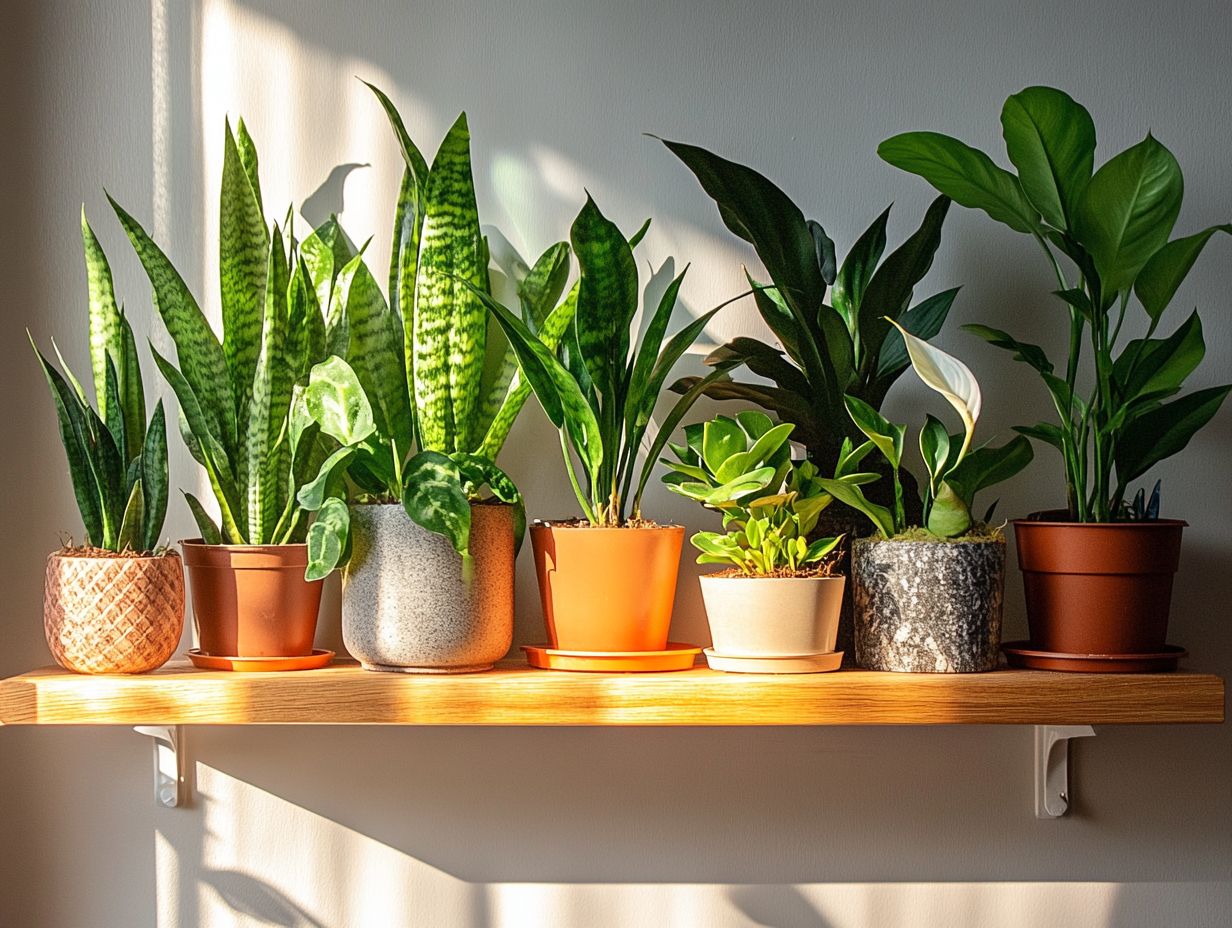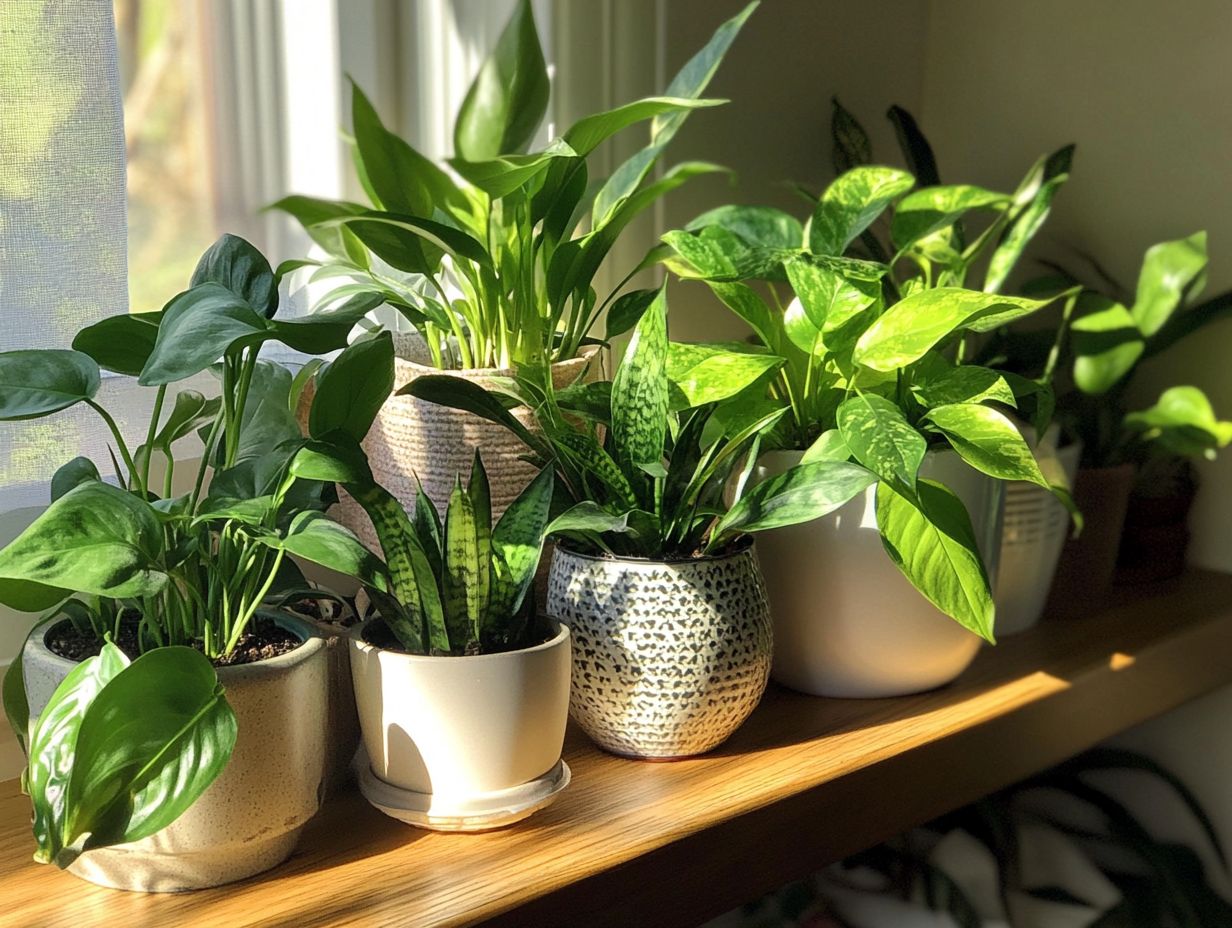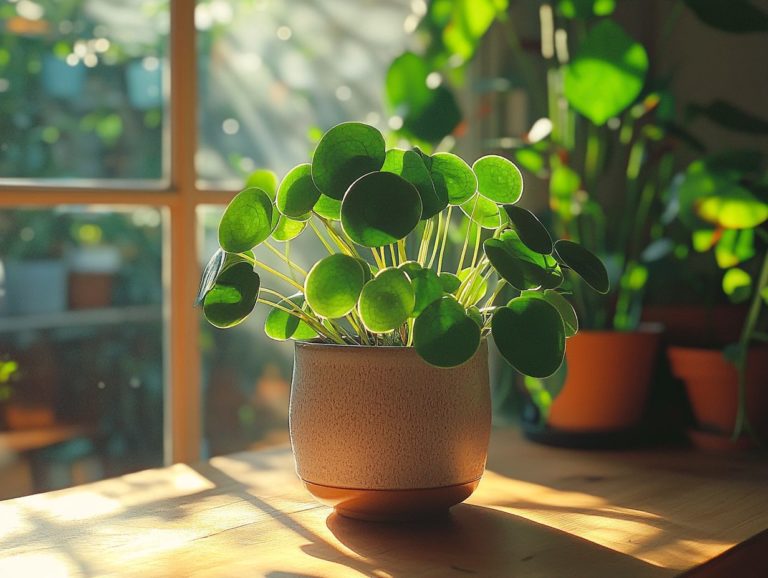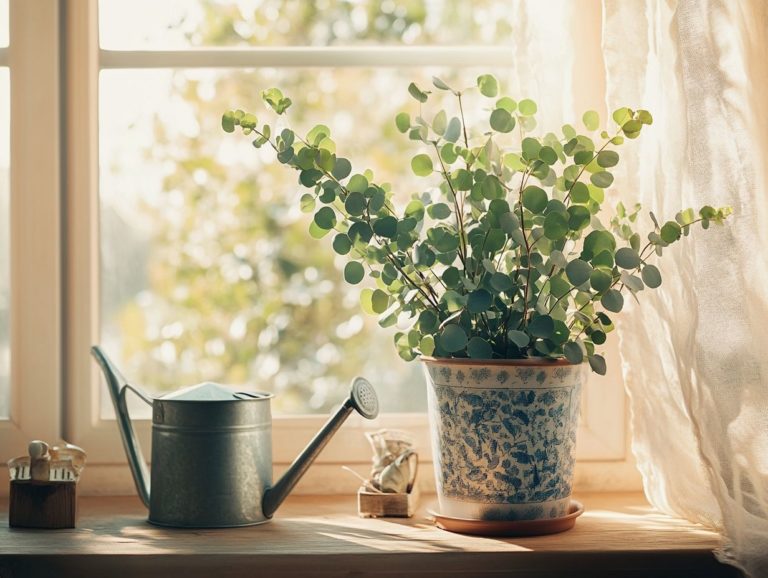Best Indoor Plants for Beginners
Bringing nature indoors can transform your space and elevate your well-being. This guide will walk you through the best indoor plants for beginners, from the resilient Spider Plant to the striking Fiddle Leaf Fig.
Discover how each plant thrives in your home. We’ll also cover essential tips on choosing the right one, caring for it, and avoiding common mistakes.
These plants can clean the air in your home. Get ready to find the perfect plant that will brighten your space, whether it’s a rubber plant or a monstera deliciosa!
Contents
- Key Takeaways:
- 1. Spider Plant
- 2. Snake Plant
- 3. Peace Lily
- 4. Aloe Vera
- 5. Pothos
- 6. Jade Plant
- 7. ZZ Plant
- 8. Cast Iron Plant
- 9. Rubber Plant
- 10. Philodendron
- 11. Chinese Evergreen
- 12. Dracaena
- 13. Boston Fern
- 14. Prayer Plant
- 15. Fiddle Leaf Fig
- What Are the Benefits of Having Indoor Plants?
- Frequently Asked Questions
Key Takeaways:

- Start with easy-to-care-for plants like spider plants and snake plants, including the popular golden pothos and ZZ plant.
- Consider the amount of light and space you have when choosing an indoor plant.
- Proper watering, light, and pruning are key to keeping indoor plants healthy and thriving.
1. Spider Plant
The Spider Plant, or Chlorophytum comosum, is a favorite for its lush green leaves and ability to clean the air. It s perfect for anyone looking to add easy-care houseplants, especially beginners.
This resilient beauty thrives in bright, indirect light but adapts well to lower light. Caring for it is easy just water occasionally and let the soil dry out between sessions.
If you want more plants, snip off the baby shoots, called pups , and place them in water until they grow roots. Common issues like browning leaf tips can usually be fixed by adjusting your watering routine and checking humidity.
2. Snake Plant
The Snake Plant, with its striking upright leaves and remarkable resilience, is a true gem for indoor plant enthusiasts. It’s hailed as one of the best low-maintenance plants, making it perfect for those who wish to enjoy the elegance of houseplant care without the fuss.
This hardy succulent thrives in various lighting conditions and even boasts air-purifying properties, making it an intelligent choice for enhancing your indoor environment. To ensure optimal growth, place it in indirect sunlight this way, it can flourish without the risk of leaf scorch.
Remember, light and infrequent watering is essential; overwatering can lead to root rot, a common pitfall for less experienced plant caretakers.
With just a bit of mindfulness regarding its placement and water needs, the Snake Plant can effortlessly become a stylish focal point in any room, showcasing the beauty of low-maintenance plants.
3. Peace Lily
The Peace Lily, or Spathiphyllum, is a true gem, admired not just for its graceful white blooms but also for its remarkable ability to clean the air. This makes it a favorite for beginners in houseplant care, alongside plants like the rubber plant or the fiddle leaf fig.
The lush green leaves provide a stunning contrast to the pristine flowers, elevating any interior decor. To keep this beauty flourishing, you ll want to strike a balance with moderate watering and indirect sunlight. It thrives when its soil is slightly moist but never soggy.
Position it near a window with filtered light. Too much direct sunlight can scorch those lovely leaves. If you notice the foliage starting to droop, a quick check of the water levels will typically indicate whether it needs a drink.
On the flip side, yellowing leaves might suggest that you ve overwatered, prompting a reassessment of your watering routine. With the right care, the Peace Lily not only enhances your space but also actively filters indoor air pollutants, making it one of the many amazing houseplant care options available.
4. Aloe Vera
Aloe Vera, scientifically known as Aloe barbadensis miller, is celebrated for its remarkable medicinal properties and effortless care, making it a premier choice for indoor plants. This is especially true for those of you who are just starting out and want low-maintenance houseplants that thrive with minimal fuss.
It adds a refreshing touch of greenery to your surroundings. It also brings benefits that enhance skincare and your overall well-being.
Its soothing gel is a go-to remedy for alleviating sunburns, hydrating the skin, and promoting healing, making it a must-have in countless beauty routines. Aloe Vera also supports digestion and gives your immune system a nice little boost.
To ensure your Aloe Vera flourishes, place it in a spot where it can soak up bright, indirect light. Water sparingly, allowing the soil to dry completely between watering sessions.
Regarding growing new plants, simply taking offsets or leaf cuttings can yield new plants, including Echeveria, which is a type of succulent. This transformation turns the process into an enjoyable project for any plant lover.
5. Pothos
Pothos, or Epipremnum aureum for those who enjoy a bit of botanical flair, is a favorite among plant enthusiasts, both seasoned and new. Its trailing vines and glossy leaves make it an ideal choice for anyone eager to bring some greenery into their home with minimal effort.
This resilient beauty thrives under a variety of lighting conditions, from bright, indirect sunlight to those dim nooks where other plants dare not venture.
To keep your Pothos happy, allow the soil to partially dry out between waterings. Don t forget to occasionally wipe its leaves to remove dust and let its natural shine radiate.
Its low-light tolerance makes it a great fit for those shadowy corners or even your office desk. If you’re feeling adventurous, growing new plants from Pothos is a breeze.
Just snip a vine with a few leaves and place it in water or soil until it roots. You can also enhance your space by training its elegant vines around trellises or along shelves, adding a vibrant touch to your indoor garden.
6. Jade Plant
The Jade Plant isn’t just celebrated for its charming succulent leaves; it’s also a symbol of good fortune. This makes it an ideal choice for indoor decor that effortlessly complements a variety of styles. This plant is perfect for both beginners and those who appreciate low-maintenance greenery.
Thriving in bright, indirect sunlight, the Jade Plant keeps its leaves looking vibrant and plump, a sight to behold. Remember: less is more when it comes to watering.
Allowing the top inch of soil to dry out between waterings encourages a healthy root system. Opt for a well-draining soil mix that includes sand or perlite to keep root rot at bay.
Not only does this resilient succulent boast an impressive lifespan often flourishing for decades but it also integrates seamlessly into various plant care strategies.
The Jade Plant is a rewarding addition to any indoor garden, enhancing both your space and your plant parenting journey.
7. ZZ Plant

The ZZ Plant, scientifically known as Zamioculcas zamiifolia, is perfect for anyone who wants an easy care option. It thrives effortlessly in various lighting conditions.
This remarkable plant has thick, glossy leaves that add a vibrant touch to your living spaces. They also serve the practical purpose of water storage.
Its ability to flourish in low-light environments and endure periods of neglect makes it a forgiving companion. This is perfect for those who might not consider themselves plant aficionados.
When you water it sparingly, the ZZ Plant demonstrates unique resilience. This ensures that even the busiest individuals can enjoy a vibrant green presence without the burden of constant upkeep.
Bring home a ZZ Plant and transform your space with minimal effort while cultivating a serene haven of tranquility.
8. Cast Iron Plant
The Cast Iron Plant, or Aspidistra elatior, truly lives up to its name with exceptional durability and resilience. It’s the ultimate low-maintenance plant for your indoor spaces, perfect for anyone seeking houseplants that can handle a bit of neglect.
Hailing from East Asia, this hardy perennial has its roots in shady forests. This is why it thrives so well in low-light conditions. Its lush, dark green leaves not only make your home look nicer but also help purify the air.
You’ll find that it requires minimal water and can flourish even in less-than-ideal soil. This makes it a fantastic choice for your busy lifestyle or any challenging setting.
Whether you place it in your home, office, or even a dimly lit corner, the Cast Iron Plant adapts easily, demonstrating that beauty and resilience can harmoniously coexist in any space. It stands as a true testament to indoor plant longevity.
9. Rubber Plant
The Rubber Plant, or Ficus elastica, is a standout choice for your indoor greenery, boasting striking dark green leaves and impressive growth. It’s not just an elegant addition to your space; it’s also one of the easiest houseplants to care for, perfect for those beginning their journey in plant parenthood.
These resilient plants thrive in bright, indirect light but are adaptable enough to handle lower light conditions, making them a versatile option for any home. Regularly water them, but let the soil dry out slightly between waterings to avoid root rot.
Like any indoor plant, they might encounter a few pests or experience leaf drop, but with your attentive care, you can manage these challenges effectively. These plants actively filter out toxins, making your air fresher and your home healthier!
10. Philodendron
Philodendron plants are a delight, valued for their astonishing variety and stunning foliage, making them a top pick for indoor plant enthusiasts. They are particularly well-suited for those just beginning their journey into houseplant care.
These enchanting plants come in various varieties, each showcasing unique leaf shapes, colors, and growth patterns. Take the Heartleaf Philodendron, for example, with its elegant, glossy green leaves, or the more dramatic Pink Princess, which turns heads with its vibrant hues.
Incorporating Philodendron into your indoor collection not only elevates your home s visual appeal but also contributes to improved air quality as they are recognized as air-purifying plants. To ensure these plants thrive, understanding their specific care requirements, like optimal light conditions and proper watering schedules, is essential.
Explore effective propagation methods, like stem cuttings, to help you grow new plants. You’ll particularly enjoy adding popular varieties such as the spider plant or snake plant.
11. Chinese Evergreen
Chinese Evergreen is a highly regarded indoor plant celebrated for its vibrant foliage and remarkable adaptability. It’s the perfect addition to your indoor garden, offering an effortless touch of elegance while requiring minimal maintenance.
With impressive varieties like the popular Aglaonema Silver Queen and the striking Emerald Bay , you’ll find an array of colors and patterns that cater to any aesthetic preference. These plants enhance your d cor with simple care requirements just provide indirect light and the occasional water.
Incorporating Chinese Evergreen into your space brings added benefits. These plants are renowned for their remarkable air-purifying capabilities, helping to filter out harmful toxins. By welcoming them into your home, you re not just elevating your environment s appeal; you re also creating a healthier and more inviting atmosphere.
Bring home these amazing plants today and watch your space transform into a green oasis!
12. Dracaena
Dracaena plants, with their striking architectural forms and vibrant leaves, are an exceptional choice for indoor gardening. These low-maintenance houseplants require minimal care and add elegance to your home interiors.
Among the diverse varieties of Dracaena, Dracaena marginata affectionately known as the dragon tree and the popular Dracaena fragrans, or corn plant, each offers its unique aesthetic and care needs. The marginata thrives in bright, indirect light and prefers to dry out between waterings, while the fragrans is quite adaptable, tolerating lower light levels and enjoying a bit more moisture.
Incorporating these plants into your d cor elevates styles from modern minimalist to bohemian chic, or even classic arrangements featuring Chinese money plant and golden pothos, enhancing the overall ambiance of your space.
To keep your Dracaena flourishing, watch for common issues like leaf spotting or wilting. These can signal that adjustments in watering or lighting are needed. With a little attention, you can ensure they thrive beautifully in your home.
13. Boston Fern
The Boston Fern, or Nephrolepis exaltata, is a true gem admired for its lush, feathery fronds and knack for thriving in humid environments. If you re looking to elevate your houseplant care routine, this vibrant air-purifying companion is your go-to.
These beauties thrive in a moist atmosphere, making them perfect for spaces like bathrooms or kitchens where humidity levels soar. To help them flourish and showcase their natural splendor, ensure consistent watering, keeping the soil damp but not waterlogged.
They prefer bright, indirect light; direct sunlight can scorch those delicate leaves. But it s not just their visual charm that makes Boston Ferns special. They are celebrated for their air-cleansing prowess, filtering out toxins and improving indoor air quality.
This fosters a healthier environment by utilizing air purifying plants and infuses your space with nature’s elegance.
14. Prayer Plant

The Prayer Plant, or Maranta leuconeura, is a true gem for your indoor garden. It’s celebrated for its stunning leaf patterns and enchanting ability to fold its leaves at night. You ll love how easy they are to care for!
These tropical wonders flourish in bright, indirect light, but too much direct sunlight can scorch their delicate leaves. Aim for consistently moist soil, avoiding standing water, which can lead to root rot.
To keep your Prayer Plant looking its best, consider using filtered water these plants can be finicky about the chemical found in tap water. Regularly misting the leaves helps maintain humidity, mimicking their natural environment. By understanding their specific needs, you can effortlessly enjoy the serene beauty of these captivating plants in your home.
15. Fiddle Leaf Fig
The Fiddle Leaf Fig, or Ficus lyrata, has become a must-have for anyone looking to elevate their indoor space. Its striking, violin-shaped leaves and commanding presence make it a standout. If you’re diving into houseplants, don’t miss the chance to own one!
To ensure your Fiddle Leaf Fig flourishes, position it where it can soak up bright, indirect sunlight. Too much direct light might scorch those beautiful leaves, while insufficient light can stifle its growth. Remember that patience is your best friend; letting the top inch of soil dry out between waterings promotes strong roots.
Be cautious overwatering can lead to root rot, a common pitfall for many eager plant parents. Regular upkeep is essential, particularly regarding humidity levels. These plants love a touch of extra moisture in the air. Don t forget to rotate your Fig occasionally to ensure all sides receive their fair share of light, keeping its growth balanced and beautiful.
What Are the Benefits of Having Indoor Plants?
Indoor plants offer many benefits that elevate your home environment. They improve air quality, enhance your mood, and boost productivity. They’re not just greenery; they’re essential companions in your journey of plant ownership, adding vibrancy and beauty to your living space.
Research has demonstrated that specific indoor plants can effectively filter out harmful pollutants like formaldehyde and benzene, significantly enhancing the air you breathe. Studies reveal that being surrounded by greenery can lower stress levels and foster relaxation, contributing to your overall emotional well-being.
Experts even suggest that the presence of plants can ignite your creativity and sharpen your focus, particularly in a work-from-home setting, thanks to varieties such as golden pothos and scindapsus pictus.
Beyond the health perks, indoor plants also elevate the aesthetic appeal of any room, transforming ordinary spaces into lively, inviting environments that cultivate a sense of calm and a deeper connection with nature.
How Do You Choose the Right Indoor Plant for Your Space?
Choosing the right indoor plant for your space involves carefully considering factors such as light conditions, humidity levels, and your lifestyle. This ensures that you select an easy houseplant that beautifully complements your home while aligning with your goals as a plant owner.
Start by assessing the natural light in your rooms. Is it drenched in bright, indirect sunlight, or does it bask in low light? For those considering plants that do well in less illumination, exploring low light indoor plants can be a great option. Different plants thrive under varying conditions, so this step is crucial.
Next, think about moisture requirements; some plants, like succulents, prefer drier soil, while others, such as ferns, flourish in humid environments. If you’re looking for options that require less care, consider indoor plants that thrive with minimal water. Choose low-maintenance plants if your schedule is packed. On the other hand, if you find joy in gardening, you may want to nurture more delicate species like orchids or fiddle leaf figs, which demand a bit more attention as they settle into their new surroundings.
What Are Some Tips for Caring for Indoor Plants?
Effective houseplant care is essential for nurturing healthy indoor plants. By embracing straightforward strategies like proper watering, optimal lighting, and consistent maintenance, you can cultivate a thriving indoor garden that truly reflects your aspirations as a plant parent.
It’s exciting to discover the unique needs of each plant! Different species come with their own preferences for humidity, temperature, and soil type. Establishing a consistent watering schedule tailored to each specific plant is crucial, ensuring that they receive just the right amount of moisture never too much, and never too little.
Learning the when and how of repotting transferring a plant to a larger pot for better growth can give your plants the space and nutrients they need to flourish. Regularly inspecting for pests and taking preventive measures will help maintain a healthy environment, ensuring your indoor garden remains vibrant and flourishing.
What Are Some Common Mistakes to Avoid When Caring for Indoor Plants?
When you embark on the journey of caring for indoor plants, be careful not to fall into common pitfalls like overwatering, poor lighting, and overlooking signs of stress. These mistakes can hinder the growth of even the simplest houseplants and challenge your plant parenting success.
Recognizing these potential missteps is vital, as they can lead to distress signals like yellowing leaves, root rot when roots decay due to excess moisture or stunted growth. For example, striking the right balance of moisture is essential; using well-draining pots and regularly checking soil moisture levels can help you avoid the perils of overwatering. Equally important is selecting the perfect spot where your plants can bask in adequate natural light, as insufficient lighting can stifle their growth.
By honing in on these details and remaining attuned to the changes in your plants conditions, you can cultivate a thriving environment that nurtures robust, lush greenery, including Monstera deliciosa and other air purifying plants, transforming your indoor spaces into vibrant ecosystems.
How Can Indoor Plants Improve Air Quality in Your Home?
Indoor plants significantly enhance the air quality in your home by filtering out harmful pollutants and increasing oxygen levels. They re not just a beautiful addition to your space; they re essential for promoting better health through thoughtful houseplant care.
These green companions, like snake plants, peace lilies, and pothos, have a unique talent for absorbing toxins such as formaldehyde, a common indoor pollutant found in many household products, and benzene, effectively purifying your air. For those interested in enhancing their indoor space, exploring Indoor Plants That Thrive in Low Light can be beneficial. Research from NASA highlights that certain houseplants can substantially reduce indoor air contaminants, making a noticeable difference in places like offices and bedrooms.
To get the most out of them, consider positioning these plants in areas with indirect sunlight. Ensure proper drainage in their pots for optimal growth.
By clustering a few plants together, you can amplify their air-cleaning capabilities while creating a lush aesthetic that enhances your overall well-being.
Frequently Asked Questions

What are the best indoor plants for beginners?
Some of the best indoor plants for beginners include spider plants, pothos, peace lily, aloe vera, snake plant, ZZ plant, and fiddle leaf fig.
Do these plants require a lot of maintenance?
No, these low-maintenance plants are perfect for beginners. They require minimal water and can thrive in low light conditions.
Can these plants improve indoor air quality?
Yes, many of these air purifying plants are known for their air-purifying qualities. They can help remove toxins and pollutants from the air, making your indoor environment healthier.
Are these plants safe for pets?
While these plants are generally safe for pets, it’s always best to double-check before bringing them into your home. Some may be toxic to cats or dogs if ingested.
Can I grow these plants in any type of pot?
Yes, these plants can be grown in a variety of pots, such as plastic, ceramic, or terracotta. Just make sure the pot has proper drainage to prevent overwatering.
Where can I purchase these plants?
You can find these plants at your local garden center, plant nursery, or even online. Make sure to do some research on the specific plant’s care needs before purchasing.
Start adding these plants to your home today for a fresher, healthier environment!






